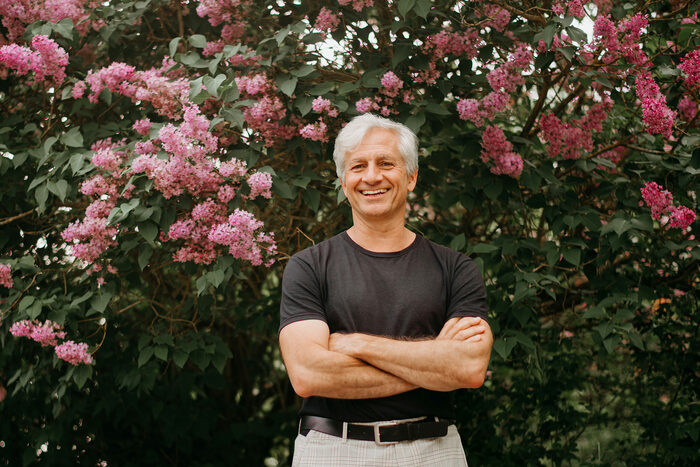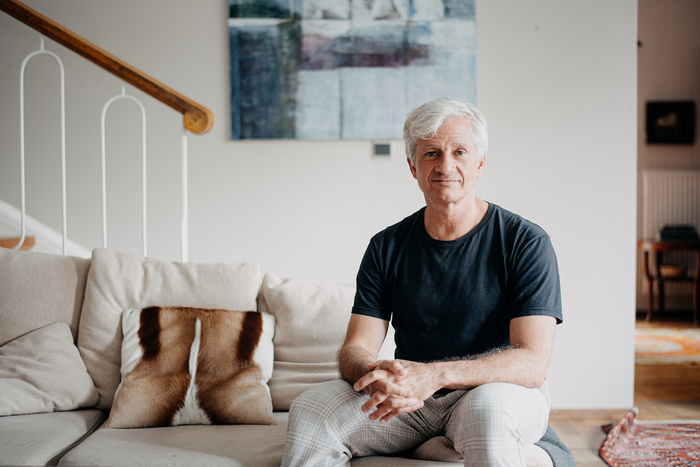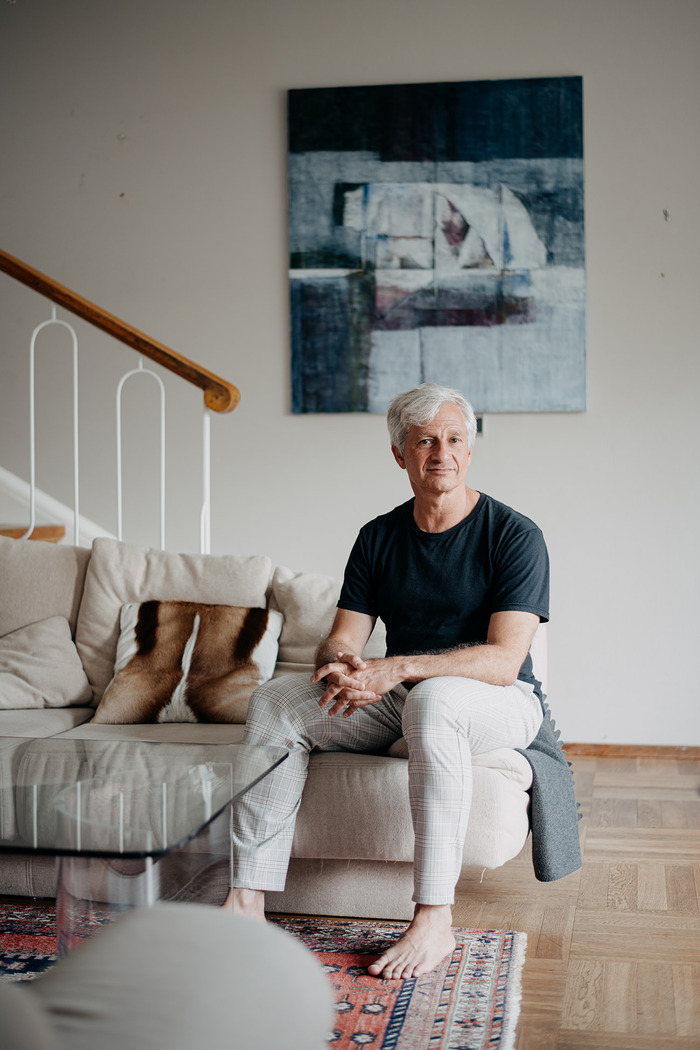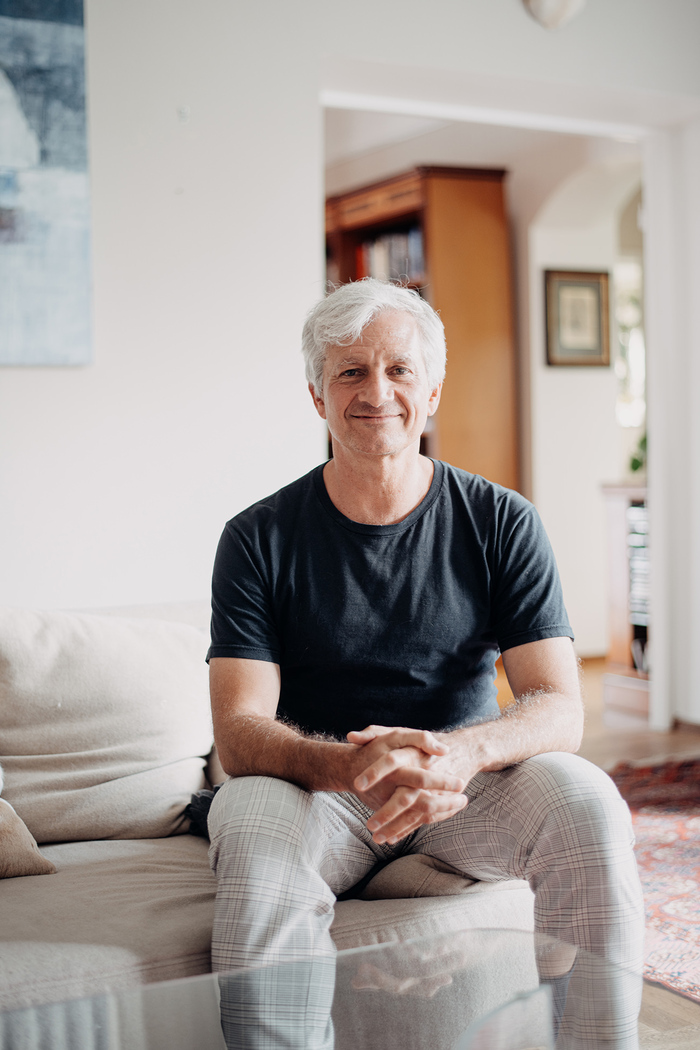
One of the wonders of European life is how fast, easy, and cheap it is to travel from one country to another by train. In less than an hour, I am whisked from Copenhagen, Denmark, to Lund in Sweden, the quaint streets of which are lined with cobblestones and storybook charm. Tucked among these streets is the beautiful home of Dr. Philippe Goldin, a world-renowned neuroscientist currently serving as a visiting professor at the Department of Psychology at Lund University. As we step inside, the space exudes that classic Nordic style—light and airy, warm wooden accents, and the gentle hum of nature outside. And, of course, Dr. Goldin’s cat, who purrs around my legs as I try to set up the cameras.
I’m here in Lund with Dr. Goldin because he is not only known for his groundbreaking research into how mindfulness and compassion-based interventions can rewire the brain, particularly in those struggling with mood disorders, anxiety, and chronic pain, but also because he is a practicing Buddhist with decades of experience. Who better to explore the intersection of neuroscience and Buddhist wisdom?
Dr. Goldin’s own journey to this corner of Sweden is as rich as it is unconventional. His academic path began with a Bachelor’s degree in Asian Studies at the University of Wisconsin-Madison, where an exchange program first introduced him to the spiritual landscapes of Nepal and India. Immersing himself in the teachings of Buddhism, he spent nearly six years in Dharamsala at Namgyal Monastery and the Dialectic Monastic Institute, delving into Tibetan philosophy, analytic debate, and the art of translation. These early experiences laid the groundwork for his later work, which we discuss throughout the interview. Enjoy!
Study Buddhism: Your journey into Buddhism took you from the lecture halls of the University of Wisconsin-Madison to the sacred monasteries of Nepal and India. What first drew you to Buddhism, and how did those early experiences—living among Tibetan lamas, translating teachings, and immersing yourself in monastic life—shape your path forward?
Dr. Philippe Goldin: At the University of Wisconsin-Madison, there was a program that allowed students to live in India or Nepal. I spent my junior and senior years in Nepal, where I was introduced to Buddhism, Islam, and Hinduism, and began studying Sanskrit, Nepali, and Tibetan. Later, I did retreats at Tibetan Buddhist centers, such as Kopan Monastery.
My deep interest in Buddhism led me to continue studying Asian studies. I returned to Madison, Wisconsin, and studied with Geshe Sopa, who was both a professor and a Tibetan Buddhist monk. When he traveled back to Tibet to visit his teacher in Lhasa, he asked if I would accompany him as a helper. I gladly accepted and spent about three to four months in Tibet, traveling with him and exploring on my own. Later, I lived at Namgyal Monastery in India for nearly four years, where I studied texts, engaged in analytic debate, learned debate language, and participated in retreats.
As my Tibetan improved, I began translating public and private teachings for various Tibetan lamas in Dharamsala. I also served as the translator for Khamtrul Rinpoche in Mustang, Nepal, for a documentary about his life. We spent an entire summer in Mustang, visiting ancient monasteries and caves, and meeting notable figures such as the king of Mustang and his family. It was a profoundly moving experience. When I eventually returned to New York City, I reflected on my life and quickly decided to apply for a Ph.D. program in clinical psychology.
As both a clinical neuroscientist and a long-time student of Buddhism, you inhabit a rare space where ancient wisdom meets modern science. How do these two worlds intersect in your work, and what insights has neuroscience offered you into core Buddhist concepts such as the nature of the self and the mind-body connection?
In brief, neuroscience applies the analytic method of scientific inquiry to understand how the brain functions, including our emotions, attention, memory, and more. It investigates how training the mind can sculpt and change the activation and interaction of different brain networks.

The Buddhist perspective, which has been very helpful to me, involves applying an ancient tradition of inquiry to explore this body-mind system, so to speak. Neuroscience has also illuminated aspects of Buddhism for me. It's a bidirectional relationship. For instance, from a neuroscience perspective, there is no concrete self in the brain. There is no “self,” “me,” or “Philippe” in my brain. While there are many self-related processes, no single network or brain region represents the self. This aligns with some of the deeper contemplative practices in Buddhism.
Neuroscience often reveals the brain as a dynamic, ever-changing network of neurons and electrical signals—an idea that resonates deeply with Buddhist teachings on impermanence and the illusion of a fixed self. How does your work in neuroscience shed light on these ancient concepts, and what do these insights mean for our everyday understanding of who we are?
Contemplation of the brain from a neuroscientific point of view reveals that there are billions of neurons and possibly trillions of connections in the brain, right this moment. There is a massive interplay of movement from moment to moment, an intricate dance of electrical signals, neurons firing, electrons, and neurotransmitters. These electrical and chemical interactions occur on a millisecond level and change every single moment. It’s hard to fathom!
So, what is the basis of our sense of self? Is there something solid and unchanging that constitutes “me”? This constant flux is a powerful, ever-changing entity that is not solid. Using a psychological term, there’s a projection of solidity onto something that is not still and solid, but ever-changing. Neuroscience offers valuable insights that complement the understandings derived from contemplative practices, which I find fascinating.
Neuroplasticity reveals the brain’s remarkable ability to adapt and transform throughout our lives. What does this mean for our potential to reshape our minds and break free from long-held patterns of thinking and behavior?
The term neuroplasticity in neuroscience describes the brain changes that occur in response to certain experiences. What are the transformative potentials of our brain?
Neuroplasticity has been a concept for the past 30 or 40 years, reflecting the brain's flexibility. It is derived from thousands of studies showing that what we do daily—whether it's eating, drinking, exercising, hugging someone, or being isolated—literally influences both the anatomy and function of our brain. For example, if you were to juggle for several hours each day over the next three weeks, the manual dexterity you develop would result in more gray matter in the areas of the brain responsible for sensory and motor hand control.
Similarly, if you're a violinist, you would develop finger dexterity, which would be reflected in changes in brain activity and matter related to finger movement. In essence, we sculpt and shape not only our prefrontal cortex but our entire brain network through our activities—reading, thinking, sleeping, and eating. This suggests that we are the architects of our own brain.
Of course, we are born with a brain influenced by our parents' and previous generations' genetics. However, we have an incredible capacity to sculpt our brain function. This indicates that our brain is not a fixed physical entity but one that can be modified. This brings hope to those who might think something is wrong with their brain or have a fixed notion of who they are. Throughout our lives, we influence our brain in the same way that going to the gym builds muscle strength and flexibility. It's amazing.
What is the relationship between the brain and the mind? Are our thoughts and experiences merely the product of neural activity, or is there something more at play?
There are different perspectives: some people believe the mind is just an epiphenomenon of neural activity, a result of neurons firing together in a neurochemical process. Others hold the opinion that the mind is separate from the brain. From a Buddhist perspective, at the gross levels, we can discuss mind, mental functions, and the brain separately.
However, at more subtle levels, there appears to be an intimate connection between physical matter and non-physical mental aspects. I would argue that there is a close link between the brain and the mind, but it is not a one-to-one relationship. For example, someone can be born with half a brain or have a portion of the brain missing from birth and still possess full mental faculties. This indicates a kind of plasticity, where brain matter can reorganize itself.

We also know that performing mental functions can influence the brain’s anatomy and function, and changes in the brain can affect mental functioning. Personally, I believe that “matter” and “non-matter,” “mind” and “brain,” exist on a continuum. At subtler levels, there may be subtle energies from which mental functions—such as language, thoughts, ideas, and memories—arise, and which in turn give rise to physical matter. In this view, energy can manifest in both physical and non-physical forms.
From my own experience and from sitting with various Tibetan lamas and teachers, it seems that physical and non-physical energies can coexist and may be more interlinked than we currently understand.
Emotions play such a powerful role in our lives, yet they often seem intangible—more like fleeting experiences than concrete realities. What exactly are emotions, and why do we have them?
Has anyone ever actually seen an emotion? In fact, no. We infer that someone has an emotion because we observe changes in their facial expressions, or we measure physiological responses like heart rate or skin conductance, which are indirect indicators of emotional changes. Using brain imaging tools, we also understand that emotions are generated through various neural processes.
Awareness of emotions typically follows their rapid generation in the mind and body, occurring more quickly than our conscious awareness. For example, the physical feeling of experiencing anger, fear, awe, or love actually arrives slightly after the initial emotional response. The somatosensory cortex and the insula in the brain process these sensations, giving us a felt sense of the body.
We can understand emotions as sources of information that help us interpret what is happening at the moment, not only internally within our own inner ecosystem but also regarding the people and environment around us. The more refined our understanding of emotions is, the better we can use them to navigate our environments and complex relationships. Unfortunately, some people perceive emotions as dangerous or believe they need to be suppressed or repressed, which is a misunderstanding.
On one level, we have emotions to redirect and orient us to our surroundings. Emotions such as love or empathy drive behaviors that help us share experiences and understand others' feelings, which is crucial. They likely also aid in our social interactions. Although we now have more words to describe various emotions, such as “schadenfreude,” which might not have existed in prehistoric times, the experiences they describe have always been present. Currently, there is a shift towards viewing emotions as resources rather than dangers.
Our minds often seem wired to dwell on negative thoughts, even when there’s no real threat. Why is it so easy to get stuck on negativity, and what practical steps can we take to break free from these mental patterns?
Research has shown that, in general, there's probably a ratio of about five negative thoughts to one positive thought. This suggests that from an evolutionary perspective, there must be a reason for our negative bias, such as preparing us for potential threats—whether real or imagined—and ensuring we respond effectively.
There is something about the negative bias that might serve a function in some contexts, driving our attention and readiness to respond to things that could be threatening, whether physically, mentally, or socially.
Negative thoughts might be more "sticky" because they can generate more arousal. While there are positive emotions that also have high arousal or energy, some positive emotions are low in arousal. Negative emotions, on the other hand, generally engage the brain more intensely, perhaps giving us a readiness to act.
However, when we find ourselves in situations where there isn’t a lot of actual threat, these negative thoughts or biases can undermine our well-being. Thus, it becomes essential to learn more about our specific patterns of negative thoughts and emotions and to create a bit of space from them—a buffer, so to speak.
Buddhism usually teaches that emotions like anger and jealousy are obstacles to a healthy mind. From a neuroscientific perspective, is it possible to experience and express these challenging emotions while still maintaining mental well-being?
The term “emotional intelligence” refers to the ability to be aware of and understand one’s own emotions, to empathize with others, and to regulate emotions effectively. More colloquially, emotional intelligence also encompasses resilience, confidence, courage, and skillfulness in managing emotions for both personal and interpersonal benefits.
A person with high emotional intelligence experiences a full spectrum of emotions without feeling the need to control or repress any of them, whether positive or negative. They are comfortable with the energy that different emotions bring and can navigate complex social relationships. They understand others' intentions and emotional states.

What about emotions like anger, jealousy, or sadness? Can a person maintain an optimally healthy mind while experiencing or even expressing these emotions? In certain contexts, experiencing and expressing such emotions may be crucial. For instance, if Tibetans do something that His Holiness the Dalai Lama considers inappropriate, he might use anger to communicate this. Similarly, parents often use anger to set boundaries for their children or teenagers. Using different emotions skillfully and contextually can be beneficial.
The key aspect of an emotionally healthy mind is psychological flexibility. This means not being stuck or trapped in any single emotion but having the ability to experience a range of emotions and adapt as needed.
Anxiety is often described as a defining emotion of our time. What exactly is anxiety, and how can we learn to recognize and manage it before it becomes overwhelming?
Anxiety is an emotion that is often driven by fear or worry about something that has not happened yet. It is inherently future-oriented. From one perspective, you might think, “Well, if feeling anxious helps to prepare me for what I think is coming, then maybe there’s something beneficial about that, right?” However, if anxiety reaches a level where it starts to inhibit your ability to engage with life and to use your human capacities to connect with others, then it becomes corrosive. Much of the impact of anxiety depends on its context and how it functions in your life. To manage anxiety effectively, it is crucial to become aware of the thinking patterns that lead to it. Ask yourself: Is this anxiety helpful or not? If you find that anxiety is paralyzing your behavior or thoughts due to its intensity, then it becomes necessary to develop strategies to cope with it.
For instance, you might recognize a thought that triggers this anxious feeling and remind yourself that such feelings are temporary. Reflect on past instances where you experienced similar levels of anxiety and how it eventually subsided. Understanding that anxiety is impermanent and changeable can provide some relief.
Another approach is to handle anxiety skillfully. Although it is a negative emotion, it also carries a certain amount of energy. Imagine being able to extract the energy from anxiety while leaving the negative valence behind. Use this energy, which often drives tension and decision-making, to gain insights into the nature of your own body and mind. This understanding can also foster sympathy or compassion for others who experience similar levels of anxiety.
There isn’t a specific brain pattern that definitively indicates anxiety, but parts of the amygdala, which are involved in emotional responses, may show increased activity. Anxiety might also manifest through physiological changes such as a rapid heartbeat, increased skin conductance, or altered respiration rate. These external indicators can signal that someone might be experiencing anxiety. The preservation of these responses suggests that anxiety once served a functional purpose. The key is to become a skilled manager of anxiety, utilizing its energy effectively without being overwhelmed by it.
In summary, recognizing anxiety involves understanding its context, acknowledging its temporary nature, and skillfully managing its energy. By becoming aware of your anxiety patterns and utilizing strategies to cope with them, you can navigate anxiety more effectively and reduce its negative impact on your life.
You co-developed the Compassion Cultivation Training program at Stanford University. What inspired the creation of this course, and how does it help participants develop deeper empathy and connection with others—including themselves?
The Compassion Cultivation Training program was put together by a few of us at Stanford, and was inspired by Thubten Jinpa, who came to Stanford for a fellowship, and spent some time with us there in residence. One of our aims of the program was to identify a sequence of compassion practices and put it into an eight-week package which became the Compassion Cultivation Training program. It contains a sequence of compassion practices towards others, towards a friend, an enemy, a stranger, towards yourself, and universal compassion towards all living beings. It includes tonglen practice, which means taking on suffering and giving well-being to others.
It's a good complement to Mindfulness-Based Stress Reduction in that trying to cultivate compassion really helps people to think about others. Our training program is relational, whereas lots of the mindfulness practices, especially as done in the West, are very much intra-psychic: It's about “me,” and not necessarily always “other-oriented.”
One of the practices I lead is called Just Like Me, which is a combination of loving-kindness meditation, plus guided statements with another human being, where you think about other people, you look at them, and then you also stop looking and go inside. You keep repeating this intermittent connection and retreat. You think about how this person has felt deep despair and sadness just like me. This person wants to lead a meaningful life, to be appreciated, to be respected, to be loved just like me.
This practice can be incredibly powerful in developing equanimity, even a sense of love, a sense of caring and compassion, and clearly a sense of connection.
One of the variations is that at some point towards the end of the exercise is to imagine yourself in front of yourself and say, “This person, me, in front of me, wishes to be respected, to be loved, will have moments of depression, anxiety, angst, just like me.” This brings in that very important relationship, which is oneself with oneself, which is often neglected, and we hardly ever get any education about that.
If over a year you did this practice of connecting with a person in silence, intimately, genuinely, if you walked through the door and saw that person, you would have a very different automatic empathic resonance with that person, that is probably measurable in the brain. People would feel less isolated and be more kind with each other.
What challenges have you encountered while teaching compassion training, and what surprising insights have you gained about how people cultivate genuine compassion—for both others and themselves?
Developing compassion doesn't even have to be directed towards a human being. In fact, one thing we’ve learned is that for many people, trying to generate love and care for a pet is often much easier than for a human being, due to past traumatic experiences or insecure attachments.
For some people, extending a sense of care and love to all beings can be daunting. In such cases, you can start with someone who is a real person or partner. It can also include people from the past or future. For example, when we think about climate change, we consider the animals and human beings who will be born. Out of compassion for them and concern for the conditions that might bring them suffering, we can cultivate an energy to take action on their behalf. We know that it’s sometimes easier to generate compassion for one being and then try to amplify it.

A good litmus test is to see how you react when you walk down the street and encounter someone with a broken leg, or someone who clearly looks unwell. Often, we can have a very spontaneous and authentic sense of caring and compassion for such individuals. However, to truly gauge whether your compassion is stable and spreading, you should also try to generate compassion for someone who appears to have everything together, with no visible signs of suffering or pain.
As you practice, this spontaneous compassion can begin to expand and extend towards more and more people. You can gradually extend and stabilize the scope of your compassion, which is an interesting way to assess the level of your real compassion.
In many cultures, death is a source of fear and avoidance, yet in Tibetan Buddhism, reflecting on mortality is seen as a powerful practice. How can contemplating death and impermanence lead to a more blissful and transcendent state of mind?
One of the things that surprised me as a 20 or 21-year-old when I encountered Tibetan Buddhism and Tibetans was the focus on decay, death, impermanence, and the loss of this body and mind. For most people, these subjects would be terrifying and induce fear and sadness, given our cultural perspectives. However, I realized that it was quite the opposite: death provides a basis for generating a state of mind that can be blissful, curious, and transcendent. Death, impermanence, and letting go can be profoundly transcendent. That realization was mind-blowing to me.
For example, there is a simple practice that Tibetans use: every night before going to sleep, you turn a cup upside down and remind yourself, 'I am now going to sleep and may or may not wake up. So, what is my true intention?' When you wake up the next morning, you turn the cup right side up to greet the new day. It symbolizes another day, another opportunity to train the mind.
Reflecting on impermanence and death throughout the day can serve as a reminder to return to a powerful, essential state of mind. Neuroscience provides interesting insights here. The term apoptosis refers to the process by which cells die, a fundamental principle that allows other cells in the brain to flourish. It's fascinating to consider that the impermanence of certain parts of our mind, body, cells, and neurons facilitates the flourishing of other cells. This principle of re-energizing and reinforcing the cells we need is fundamental to our existence.
For those new to the practice, could you guide us through a simple death meditation that helps cultivate an appreciation for impermanence and the transient nature of life?
There are many forms of death meditation practice in the Hinayana and Mahayana traditions. A very brief practice to contemplate death involves focusing on the four elements: earth, water, fire, and air. You can do this practice either while seated or even while in motion.
We start with the earth element. Consider the physical constituents of your body. Imagine billions and billions of cells that make up the body beginning to shrink or slow down.
Next is water: fluid, blood, cerebrospinal fluid, which is continuously moving. Imagine all of that fluid movement starting to slow down and come to stillness.
Move to fire: think about how the blood continuously generates warmth and distributes it throughout the body, including your heart. Visualize all the warmth beginning to dissipate, and the body becoming cold.
Then air: consider the air in terms of respiration, or breathing. Imagine that your breath begins to get shallow and then eventually stops. There is no more movement of air through the nose or lungs, no more oxygen delivered to the cells of the body.
You might also consider a fifth element, sky or consciousness. As your name, self, words, and language begin to dissolve, there is no more thought.
Out of compassion, we then regenerate the energy of earth, water, fire, air, and consciousness or sky—the components that make up a human being. We regenerate and reshape them with care and compassion for others. This practice can be done quickly in a few breaths, over a few minutes, or extended over an hour.
By practicing regularly, you can develop an appreciation for impermanence and the transient nature of being. Anything used to identify oneself is changing from moment to moment.
Meditation and mindfulness are often used interchangeably, but they aren’t quite the same. How do these practices differ, and what role does each play in cultivating a balanced and present mind?
Many people wonder about the relationship between mindfulness and meditation. In Sanskrit, the word for meditation is bhāvanā, which means to cultivate. It’s an agricultural metaphor of planting seeds in the field. Meditation refers to many different contemplative techniques used to cultivate specific positive or beneficial qualities and to deepen our understanding of how our mind and body work.
Mindfulness of body, mindfulness of impermanence, mindfulness of thoughts, emotions, and sensations are subsets of practices within the broader scope of many different meditation practices.
Mindfulness, in Sanskrit, Pali, and Tibetan, has different meanings depending on how we train the mind. One meaning is to remember. This raises the question: What is it that I’m remembering? Is it merely remembering to be in the present moment? In another context, it refers to the quality of the mind that adheres to whatever you’re paying attention to, an object.
John Kabat-Zinn has defined mindfulness in the West, but I also like to think of it as a fierce courage to fully engage with and relate to the present moment, whether it is pleasant or unpleasant. It takes courage to truly experience the current moment in its fullness.
There are many techniques under the term mindfulness, which are a set of meditation practices or technologies for training the mind, all helping to bring the mind into greater contact with reality.

Since the current moment is different from moment to moment, being fully aware of all the forces and conditions present can be overwhelming. That’s why mindfulness requires courage, a stable mind, and a motivation to experience and be aware of even a subset of what is happening both internally and externally.
Mindfulness is indeed a growing trend, and the McMindfulness Movement offers a crucial critique. It suggests that mindfulness might be used in organizations to shift the responsibility for well-being onto individuals rather than addressing necessary structural changes that could lead to greater equality and equity. In the West, mindfulness is sometimes portrayed as if it alone is sufficient for fundamental change. However, ethical understanding, ethical conduct, and support from a community are also vital. Thus, mindfulness practices alone are not enough for the full development of a human being; more is needed.
What can neuroscience and neuroimaging tell us about the effects of meditation on the brain, and how close are we to understanding the neural signatures of practices like mindfulness and compassion?
The brain is beautiful and complex, and we have maybe eight or nine different modalities of neuroimaging to explore how the brain functions. Each of these modalities has its own strengths and weaknesses, providing us with different types of information. Currently, we do not have the capability to precisely extract specific brain activity that indicates someone is in a state of mindfulness, nor can we pinpoint exact moments of compassion with that level of specificity. However, we do know that various contemplative practices can enhance self-awareness and increase awareness of bodily sensations.
We are investigating how different practices produce similar or distinct effects on neural networks. For instance, a classic finding involved Tibetan Buddhist monk Matthieu Ricard, a Frenchman, who was studied using EEG (electroencephalography) to measure electrical signals in the brain. Early research showed that Matthieu Ricard was able to generate an asymmetry in brain activity between the left and right frontal lobes. Greater activity in the left frontal lobe has been associated with more prosocial, other-oriented states of mind compared to the right. His brain activity pattern was notably different from that of the control participants.
As a psychologist, I recognize that individual differences play a significant role. Some individuals may show substantial changes with minimal contemplative practice, while others may require longer training periods. For example, ten minutes of meditation daily differs greatly from ten hours a day of silent meditation over two weeks.
A fascinating question is how a specific practice, such as focusing on bodily sensations or cultivating love and care for all beings, affects a person for the rest of the day. New tools are emerging to probe this question beyond self-reports. For instance, we can investigate if brain activity changes throughout the day after a morning practice at 8 a.m. This is intriguing because it suggests that contemplative practices or psychotherapy might influence how we orient ourselves for the rest of the day."
Dr. Goldin, thank you so much for sharing such incredibly rich and deep insights with us at Study Buddhism!